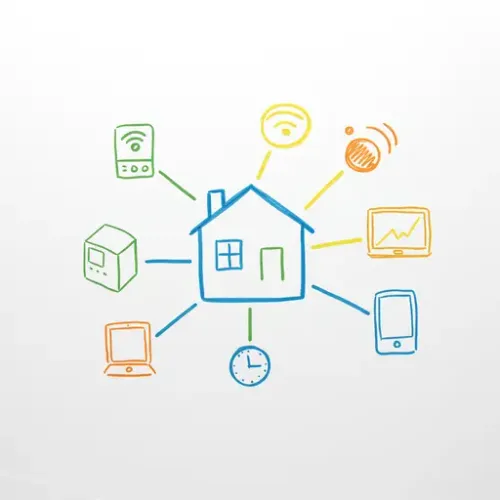Mastering Tasmota Integration with Home Assistant via MQTT: Unlocking Versatile Device Control

NGC 224
DIY Smart Home Creator
Tasmota is a popular open-source firmware for ESP8266, ESP8285, ESP32, and other devices. It replaces the original proprietary firmware on many inexpensive smart plugs, switches, lights, and sensors, freeing them from cloud dependencies and enabling local control. While ESPHome is another excellent option, Tasmota offers a different feature set and configuration approach, often managed via a built-in web UI and command line. The most common and powerful way to integrate Tasmota devices into Home Assistant is through MQTT (Message Queuing Telemetry Transport).
Why Integrate Tasmota with Home Assistant via MQTT?
Integrating Tasmota devices with Home Assistant via MQTT offers several key advantages:
- Local Control: Devices communicate directly with your local MQTT broker and Home Assistant, removing reliance on internet connectivity and external servers.
- Flexibility: MQTT allows fine-grained control and access to all device capabilities (power state, sensor readings, energy monitoring, relays, etc.) via standardized messages.
- Standardization: MQTT provides a unified communication protocol across different device types and manufacturers (when flashed with Tasmota).
- MQTT Discovery: Tasmota supports Home Assistant's MQTT Discovery protocol, allowing devices to automatically appear in Home Assistant without manual configuration in most cases.
- Customization: For advanced users, manual MQTT configuration offers complete control over how topics and payloads are interpreted.
Prerequisites
Before you begin, ensure you have:
- Home Assistant: A running instance of Home Assistant.
- MQTT Broker: An operational MQTT broker accessible by both Home Assistant and your Tasmota devices. The Mosquitto Broker Add-on for Home Assistant Supervised/OS is highly recommended for ease of use and tight integration. Alternatively, you can use a separate broker instance.
- Tasmota Device: A device successfully flashed with Tasmota firmware and connected to your local Wi-Fi network. (Detailing the flashing process is outside the scope of this article, as it varies greatly per device and method).
Setting Up the MQTT Broker in Home Assistant
If you haven't already, set up the MQTT integration in Home Assistant:
- Go to Settings -> Devices & Services.
- Click '+ ADD INTEGRATION'.
- Search for 'MQTT' and select it.
- Enter the details for your MQTT broker (hostname/IP, port, username, password). If using the Mosquitto add-on, these details are often pre-filled or readily available from the add-on configuration/documentation.
- Submit the configuration. Home Assistant should connect to the broker.
Configuring Tasmota Device for MQTT Communication
Once your Tasmota device is running and connected to your Wi-Fi, access its web interface by typing its IP address into a web browser.
- Go to 'Configuration' -> 'Configure MQTT'.
-
Fill in the MQTT broker details:
- Host: The IP address or hostname of your MQTT broker (e.g.,
192.168.1.100ormqtt.local). - Port: The port your MQTT broker listens on (usually
1883). - Client: A unique name for this device (e.g.,
tasmota_livingroom_plug). Tasmota automatically appends the device MAC address segment, making it unique. - User: The username for authenticating with the MQTT broker (if authentication is enabled).
- Password: The password for the MQTT user.
- Topic: A unique base topic for this device (e.g.,
tasmota/livingroom/plug). This topic is used for sending commands to the device. Use forward slashes (/) for hierarchy. Avoid spaces or special characters. - Full Topic: Leave this as the default (
%prefix%/%topic%/) unless you have specific advanced needs. The default prefixes arecmnd,stat, andtele. - Group Topic: Optional, allows controlling groups of devices simultaneously.
- Fallback Topic: Optional, a backup topic.
- Host: The IP address or hostname of your MQTT broker (e.g.,
- Click 'Save'. The device should restart and attempt to connect to the MQTT broker.
You can verify the connection in the Tasmota Console (Main Menu -> Console). Look for messages indicating connection success and subscription to topics.
Enabling MQTT Discovery for Home Assistant
Tasmota's MQTT Discovery feature simplifies integration significantly.
- In the Tasmota web UI, go to the Console.
- Type the command
SetOption19 1and press Enter. - Type the command
Restart 1and press Enter.
Once the device restarts, it will publish configuration topics to the MQTT broker that Home Assistant (if its MQTT integration is configured with discovery enabled, which is the default) will pick up. The device should automatically appear in Home Assistant under Settings -> Devices & Services -> MQTT, often listed under 'Devices' or prompting you in 'Configuration' -> 'Integrations'.
Home Assistant will typically create entities based on the device's capabilities (e.g., a switch entity for a smart plug, sensor entities for temperature/humidity if configured, etc.).
Manual MQTT Configuration (When Discovery Isn't Enough)
Sometimes, you might need to configure devices manually, for example, if you disable discovery, have complex scenarios, or specific sensors/features Tasmota doesn't automatically expose optimally via discovery.
Manual configuration involves adding entities directly to your Home Assistant configuration (configuration.yaml or split files) using the mqtt platform.
Example: Manual Switch Configuration
mqtt:
switch:
- name: "Living Room Plug Manual"
state_topic: "stat/tasmota_livingroom_plug/POWER"
command_topic: "cmnd/tasmota_livingroom_plug/POWER"
payload_on: "ON"
payload_off: "OFF"
state_on: "ON"
state_off: "OFF"
optimistic: false
qos: 0
retain: true # Should match Tasmota's SetOption0 setting
Explanation:
name: A friendly name for the entity.state_topic: The MQTT topic Home Assistant subscribes to for the current state. Tasmota publishes state changes tostat/<your_topic>/POWER.command_topic: The MQTT topic Home Assistant publishes to to control the device. Tasmota listens for commands oncmnd/<your_topic>/POWER.payload_on/payload_off: The messages sent by Home Assistant to turn the device on/off.state_on/state_off: The messages expected by Home Assistant in thestate_topicto indicate the device's state. Tasmota typically sends 'ON' or 'OFF'.optimistic: Set tofalseif you want Home Assistant to wait for confirmation from the device on thestate_topicbefore updating the UI.qos: Quality of Service level (0, 1, or 2). QoS 0 is fire-and-forget, QoS 1 ensures delivery. QoS 0 is often sufficient for simple devices.retain: Set totrueif the state messages published by the device should be retained by the broker. This helps Home Assistant get the correct state immediately on startup. EnsureSetOption0 1is set in Tasmota's console.
Example: Manual Sensor Configuration
Sensor data often comes in JSON format on the tele/<your_topic>/SENSOR topic (published periodically) or stat/<your_topic>/STATUS8 (published on command/request). You use the value_template to extract the specific value.
mqtt:
sensor:
- name: "Living Room Plug Energy Power"
state_topic: "tele/tasmota_livingroom_plug/SENSOR"
unit_of_measurement: "W"
value_template: "{{ value_json. శక్తి.Power }}"
device_class: "power"
state_class: "measurement"
- name: "Living Room Plug Energy Total"
state_topic: "tele/tasmota_livingroom_plug/SENSOR"
unit_of_measurement: "kWh"
value_template: "{{ value_json. শক্তি.Total }}"
device_class: "energy"
state_class: "total_increasing"
Explanation:
state_topic: The topic where sensor data is published (tele/.../SENSORis common for periodic updates).unit_of_measurement: The unit of the value.value_template: A Jinja2 template to extract the desired value from the JSON payload. Usevalue_jsonto access the JSON object. Note the example uses keys from a common Tasmota energy monitoring payload (' శక్తి': { 'Power': 10.5, 'Total': 123.4 }). Inspect your device's console output or MQTT messages to find the exact JSON structure.device_classandstate_class: Provide semantic information for Home Assistant, enabling features like the Energy dashboard.
Remember to restart Home Assistant after modifying configuration.yaml for manual configurations to take effect.
Best Practices for a Reliable Tasmota + Home Assistant Ecosystem
- Use MQTT Discovery When Possible: It's the easiest and most maintainable method. Only resort to manual configuration for specific needs.
- Ensure Unique MQTT Topics: Every Tasmota device needs a unique Topic set in its configuration. This prevents command conflicts.
- Use Descriptive Topics: Name your topics logically (e.g.,
location/device_type/namelikekitchen/light/main). - Set Static IPs: Assign static IP addresses or DHCP reservations to your Home Assistant server, MQTT broker, and Tasmota devices. This prevents them from changing IPs and breaking communication.
- Enable Retain (SetOption0 1): In the Tasmota Console, set
SetOption0 1. This tells the device to publish state messages with the MQTT retain flag, ensuring Home Assistant immediately receives the last known state when it starts up or reconnects. Configure your manual MQTT entities withretain: trueaccordingly. - Configure QoS: While QoS 0 often works, consider QoS 1 for critical devices (like door locks or security sensors) if your network isn't perfectly reliable, although this adds overhead. Ensure both Tasmota (
SetOption63 1) and Home Assistant configuration match the desired QoS level. - Secure Your MQTT Broker: Always use authentication (username/password) for your MQTT broker. Consider TLS/SSL if your broker and devices support it, especially if accessing the broker from outside your local network (though local-only access is recommended).
- Monitor MQTT Activity: Use tools like MQTT Explorer (a desktop client) to connect to your broker and view the topics and messages being published. This is invaluable for debugging.
- Check Tasmota Console: The Tasmota web UI's Console provides detailed logs about MQTT connection status, received commands, and published messages.
- Monitor Device Availability: Home Assistant's MQTT integration automatically provides 'availability' topics for devices configured via discovery or manual configuration with
availability_topic. This lets you know if a device is online or offline. Tasmota publishes LWT (Last Will and Testament) messages by default, making this work out of the box with discovery.
Troubleshooting Common Issues
- Device Not Appearing (Discovery): Double-check the MQTT settings in Tasmota, ensure
SetOption19 1is active, and verify the MQTT broker details match in both Tasmota and Home Assistant. Check Home Assistant's system logs and the Tasmota Console for connection errors. - State Not Updating (Manual Config): Verify the
state_topicin Home Assistant exactly matches the topic Tasmota publishes state to. Use MQTT Explorer to see what topics Tasmota is actually publishing and the format of the payload. - Commands Not Working (Manual Config): Verify the
command_topicin Home Assistant exactly matches the topic Tasmota is listening on for commands. Check the Tasmota Console to see if the command is being received. - Permissions: Ensure the MQTT user/password has permissions to publish and subscribe to the relevant topics on the broker.
Conclusion
Integrating Tasmota devices with Home Assistant via MQTT is a powerful way to build a flexible, local, and reliable smart home. By leveraging MQTT Discovery or mastering manual configuration, you gain complete control over your devices, bypassing cloud dependencies and opening up possibilities for complex automations and monitoring within your Home Assistant ecosystem. With careful configuration and adherence to best practices, your Tasmota devices will become seamless and robust components of your smart home.

NGC 224
Author bio: DIY Smart Home Creator
